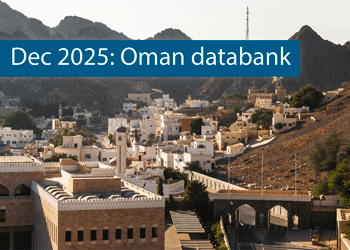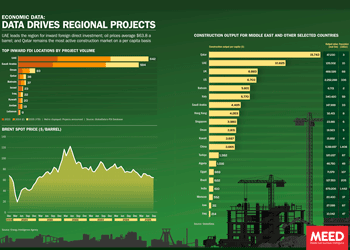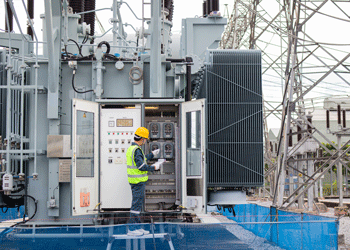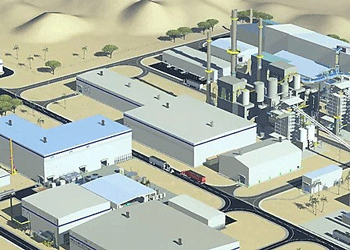Qatar economy rebounds alongside diplomatic activity
13 January 2025

Qatar welcomed some 5.1 million visitors in 2024, the highest number on record and representing a 25% year-on-year increase. But the growing waves of holidaymakers have not been the only notable arrivals of late – regional political figures have also been showing up, as Doha resumes its efforts to resolve the Gaza conflict while also seeking to play a role in rebuilding Syria.
The diplomatic activity comes at a time when the broader economy is emerging from its post-World Cup slump. After the football tournament ended in 2022, there was something of a slowdown, as activity in the construction and services sectors eased off.
According to the Washington-based IMF, real GDP growth fell from 4.2% in 2022 to just 1.2% in 2023. In its latest report on the economy, published in early December, the IMF suggested the rebound had started, with GDP growth of about 2% in 2024/25.
Over the medium term, the IMF expects growth to rise to about 4.75%, helped by a significant expansion of LNG production.
Others take a similar view. On 7 January, Dubai-based bank Emirates NBD revised down its 2024 GDP growth forecast for Qatar to 1.7%, from 2% previously. But it said it expects growth to tick up to 2.6% this year and then accelerate to 4.8% in 2026, as more gas exports come online.
While hydrocarbons will continue to be the most important element of the economy for many years, tourism will play an increasingly important role in economic diversification efforts.
The country now has more than 40,000 hotel rooms – substantially more than the 31,000 permanent rooms in place when the football tournament was on (augmented by 100,000 temporary rooms on cruise ships and in fan villages and rented homes and apartments).
The number of visitors since the tournament has risen substantially: from 2.6 million in 2022, the figure rose to 4.1 million in 2023 and over 5 million last year. Many more travel through Hamad International airport, which handled almost 53 million passengers in 2024, some 15% more than the year before.
Citizens of more than 100 countries are eligible for visa-free entry to Qatar. That open-minded approach also informs the country’s diplomatic activities.
Diplomatic re-engagement
On 28 December, Prime Minister and Foreign Affairs Minister Sheikh Mohammed Bin Abdulrahman Al-Thani met a Hamas delegation led by Khalil Al-Hayya to discuss a potential Gaza ceasefire deal. Doha had shuttered its mediating efforts in early November, saying neither Hamas nor Israel were engaging seriously.
In January, the diplomatic activity stepped up further, as indirect talks mediated by Qatar resumed. David Barnea, the head of Israel’s Mossad intelligence agency, travelled to Doha, as did US President Joe Biden’s Middle East envoy Brett McGurk. Early reports suggest some progress was being made.
“There are extensive negotiations. Mediators and negotiators are talking about every word and every detail. There is a breakthrough when it comes to narrowing old existing gaps, but there is no deal yet,” one unnamed Palestinian official close to the talks told Reuters.
Activity relating to Syria has been even more pronounced. Unlike some other Gulf states, Doha had resisted the urge to normalise relations with Bashar Al-Assad in recent years, even as many observers assumed his regime had survived the revolution and would continue to hold power in Damascus indefinitely.
As other countries reopened their embassies, Qatar’s remained shuttered. That changed nine days after the Assad regime fell, when the Qatari diplomatic presence in Damascus reopened for business on 17 December. Khalifa Abdullah Al-Sharif was appointed as charge d’affaires.
The new Syrian regime led by Hayat Tahrir Al-Sham (HTS) appears warmly disposed towards Doha. Visiting the Qatari capital on 5 January, Syria’s Foreign Affairs Minister Asaad Al-Shaibani described Qatar as “a strategic partner”.
On 23 December, Minister of State at the Ministry of Foreign Affairs Mohammed Bin Abdulaziz Al-Khulaifi had travelled to Damascus, where he met HTS leader Ahmed Al-Sharaa (better known during the revolution by his nom de guerre Abu Mohammad Al-Julani) to discuss bilateral relations.
Among other things, Qatar has been helping to restart operations at Damascus International airport – international flights resumed on 7 January, with the first arrival coming in from Doha (the first departure went to Sharjah). Qatar, along with Turkiye, has also reportedly pledged to supply electricity-generating ships to provide 800MW of power to the country.
Al-Shaibani’s visit to Doha in early January was part of a wider tour of key Gulf capitals. While in Qatar, he called on Western countries to remove sanctions on his country, saying they “constitute an obstacle to the rapid recovery of the Syrian economy … We renew our demand for the United States of America to lift the sanctions to speed up the recovery and start building the new Syria”.
The following day, the US announced a six-month suspension of sanctions on dealings with the Syrian government. Senior European figures have indicated they could soon take similar steps. Among other things, relaxing sanctions could enable Doha and other Arab governments to help fund salaries for Syrian public sector employees.
The health of Qatar’s public finances means such support is easy to provide. The government has consistently run a budget surplus in recent years, and that is expected to continue. Emir Sheikh Tamim Bin Hamad Al-Thani approved the budget for 2025 in mid-December. It includes spending of QR210bn ($58bn) and revenues of QR197bn, pointing to a deficit of QR13bn.
However, UK-based Oxford Economics has pointed out that the figures were based on conservative oil price assumptions. The consultancy expects Doha to actually run a surplus of QR12bn for this year, down from QR25bn in 2024 but still substantial. “These projections underscore Qatar’s fiscal discipline and sustainable policies,” it said in a 19 December report.
Exclusive from Meed
-
 Navigating financial markets amid geopolitical fragmentation
Navigating financial markets amid geopolitical fragmentation28 December 2025
-
 Oman’s growth forecast points upwards
Oman’s growth forecast points upwards24 December 2025
-
 December 2025: Data drives regional projects
December 2025: Data drives regional projects23 December 2025
-
 Local firm bids lowest for Kuwait substation deal
Local firm bids lowest for Kuwait substation deal22 December 2025
-
 Saudi-Dutch JV awards ‘supercentre’ metals reclamation project
Saudi-Dutch JV awards ‘supercentre’ metals reclamation project22 December 2025
All of this is only 1% of what MEED.com has to offer
Subscribe now and unlock all the 153,671 articles on MEED.com
- All the latest news, data, and market intelligence across MENA at your fingerprints
- First-hand updates and inside information on projects, clients and competitors that matter to you
- 20 years' archive of information, data, and news for you to access at your convenience
- Strategize to succeed and minimise risks with timely analysis of current and future market trends

Related Articles
-
 Navigating financial markets amid geopolitical fragmentation
Navigating financial markets amid geopolitical fragmentation28 December 2025

As we move towards 2026, geopolitical fragmentation is no longer a background risk that occasionally disrupts markets.
It has become a defining feature of the global financial landscape. Shifting alliances, persistent regional tensions, sanctions and the reconfiguration of supply chains are reshaping how capital flows, how liquidity behaves and how confidence is formed.
For firms operating in the Middle East, this does not simply mean preparing for more volatility. It means operating in a system where the underlying rules are evolving.
For much of the past three decades, businesses and investors worked within a broadly convergent global framework. Trade expanded, financial markets deepened and policy coordination – while imperfect – created a sense of predictability. That environment has changed.
Today, economic decisions are increasingly influenced by strategic alignment, security considerations and political resilience. Markets still function, but they do so in a more fragmented and less forgiving way.
Shifting landscape
One of the most important consequences of this shift is that risk no longer travels along familiar paths. In the past, geopolitical events were often treated as temporary shocks layered onto an otherwise stable system.
Today, they shape the system itself. Trade flows are influenced as much by political compatibility as by cost efficiency. Supply chains, once optimised for speed and scale, are reorganising into regional or allied clusters. Financial markets respond not only to data, but to narratives about stability, alignment and long-term credibility.
This change places greater pressure on firms that rely on historical relationships to guide decisions. Models built on past correlations – between interest rates and equity markets, or between energy prices and regional growth – are less reliable when markets move between different regimes. The challenge is not simply higher volatility, but the fact that correlations themselves can shift quickly.
Monetary policy adds a second layer of complexity. Major central banks are no longer moving in step. The US, Europe and parts of Asia face different inflation dynamics and political constraints, leading to diverging interest-rate paths.
For the GCC, where currencies are largely pegged to the US dollar, this divergence has direct consequences. Local financial conditions are closely tied to decisions taken by the Federal Reserve, even when regional economic conditions follow a different cycle.
This matters because funding costs, liquidity availability and hedging conditions are shaped by global rather than local forces. When US policy remains tight, dollar liquidity becomes more selective. When expectations shift abruptly, market depth can disappear quickly.
For firms with international exposure, long-term investment plans, or reliance on external financing, these dynamics require careful management. They cannot be treated as secondary macro considerations.
Energy markets further complicate the picture. The Middle East remains central to global energy supply, which means geopolitical events often interact with oil prices and financial conditions at the same time.
When shifts in energy expectations coincide with changes in global interest-rate sentiment, liquidity conditions can tighten rapidly. This interaction is well known in academic research on fixed exchange-rate systems, but its practical implications are often underestimated in corporate planning.
Expanding vulnerabilities
These dynamics expose clear vulnerabilities. Concentrated supply chains are more susceptible to disruption. Financing structures dependent on continuous market access are more exposed to sudden repricing. Risk management approaches that assume stable relationships between assets are more likely to disappoint. Operational risks – particularly in technology and data – are increasingly shaped by geopolitical considerations rather than purely technical ones.
At the same time, the region enters 2026 from a position of relative strength. GCC economies benefit from fiscal buffers, long-term investment programmes and a growing perception of stability compared to other parts of the world. In an environment where uncertainty is widespread, predictability itself becomes valuable. Capital increasingly seeks jurisdictions that combine economic ambition with institutional credibility.
The question, therefore, is not whether opportunities exist, but whether firms are prepared to capture them responsibly. This requires a shift in how future risks are assessed and embedded into decision-making. Linear forecasts and static plans are insufficient when the environment itself can change state. Scenario thinking must evolve beyond optimistic and pessimistic cases to reflect different combinations of geopolitical alignment, monetary conditions, and supply-chain stability. These scenarios should inform capital allocation, not sit in strategy documents.
Liquidity and risk management discipline also become central. In both trading and corporate finance, experience shows that many failures stem not from being wrong on direction, but from being overexposed when conditions change. Scaling risk to market conditions, maintaining funding flexibility and understanding how quickly liquidity can evaporate are essential practices. This is as true for corporate balance sheets as it is for trading books.
Operational resilience must be viewed through the same lens. Supply-chain redundancy, cybersecurity preparedness and data governance are no longer purely operational concerns. They influence financial stability, investor confidence and regulatory trust. In a fragmented world, operational disruptions can quickly translate into financial and reputational damage.
Facing the future
As we approach 2026, leadership in the Middle East faces a clear test. The global environment is unlikely to become simpler or more predictable. Firms that continue to rely on assumptions shaped by a different era will find themselves reacting rather than positioning. Those that invest in disciplined risk management, flexible planning and operational resilience will be better placed to navigate uncertainty and to turn volatility into strategic advantage.
In this environment, risk management is not an obstacle to growth. It is the framework that makes sustainable growth possible.
Ultimately – and this is an often overlooked critical point – none of these adjustments, whether in scenario planning, liquidity discipline, or operational resilience, can be effective without the right human capital in place.
Geopolitical fragmentation and financial volatility are not risks that can be fully addressed through models or policies alone. They require informed judgement, institutional memory and the ability to interpret weak signals before they become material threats or missed opportunities.
Firms that succeed in this environment will be those that deliberately invest in corporate knowledge: building internal capabilities where possible and complementing them with external expertise where necessary. This means involving professionals with the right background, cross-market experience and a proven, proactive approach to risk awareness and governance.
In a fragmented world, competitive advantage increasingly depends not only on capital or strategy, but on the quality of people entrusted with understanding risk, challenging assumptions and guiding decision-making under uncertainty.
 https://image.digitalinsightresearch.in/uploads/NewsArticle/15306336/main.gif
https://image.digitalinsightresearch.in/uploads/NewsArticle/15306336/main.gif -
 Oman’s growth forecast points upwards
Oman’s growth forecast points upwards24 December 2025

MEED’s January 2026 report on Oman includes:
> COMMENT: Oman steadies growth with strategic restraint
> GVT & ECONOMY: Oman pursues diversification amid regional concerns
> BANKING: Oman banks feel impact of stronger economy
> OIL & GAS: LNG goals galvanise Oman’s oil and gas sector
> POWER & WATER: Oman prepares for a wave of IPP awards
> CONSTRUCTION: Momentum builds in construction sectorTo see previous issues of MEED Business Review, please click herehttps://image.digitalinsightresearch.in/uploads/NewsArticle/15306449/main.gif -
 December 2025: Data drives regional projects
December 2025: Data drives regional projects23 December 2025
Click here to download the PDF
Includes: Top inward FDI locations by project volume | Brent spot price | Construction output
MEED’s January 2026 report on Oman includes:
> COMMENT: Oman steadies growth with strategic restraint
> ECONOMY: Oman pursues diversification amid regional concerns
> BANKING: Oman banks feel impact of stronger economy
> OIL & GAS: LNG goals galvanise Oman’s oil and gas sector
> POWER & WATER: Oman prepares for a wave of IPP awards
> CONSTRUCTION: Momentum builds in construction sectorTo see previous issues of MEED Business Review, please click herehttps://image.digitalinsightresearch.in/uploads/NewsArticle/15306140/main.gif -
 Local firm bids lowest for Kuwait substation deal
Local firm bids lowest for Kuwait substation deal22 December 2025
The local Al-Ahleia Switchgear Company has submitted the lowest price of KD33.9m ($110.3m) for a contract to build a 400/132/11 kV substation at the South Surra township for Kuwait’s Public Authority for Housing Welfare (PAHW).
The bid was marginally lower than the two other offers of KD35.1m and KD35.5m submitted respectively by Saudi Arabia’s National Contracting Company (NCC) and India’s Larsen & Toubro.
PAHW is expected to take about three months to evaluate the prices before selecting the successful contractor.
The project is one of several transmission and distribution projects either out to bid or recently awarded by Kuwait’s main affordable housing client.
This year alone, it has awarded two contracts worth more than $100m for cable works at its 1Z, 2Z, 3Z and 4Z 400kV substations at Al-Istiqlal City, and two deals totalling just under $280m for the construction of seven 132/11kV substations in the same township.
Most recently, it has tendered two contracts to build seven 132/11kV main substations at its affordable housing project, west of Kuwait City. The bid deadline for the two deals covering the MS-01 through to MS-08 substations is 8 January.
https://image.digitalinsightresearch.in/uploads/NewsArticle/15305745/main.gif -
 Saudi-Dutch JV awards ‘supercentre’ metals reclamation project
Saudi-Dutch JV awards ‘supercentre’ metals reclamation project22 December 2025
The local Advanced Circular Materials Company (ACMC), a joint venture of the Netherlands-based Shell & AMG Recycling BV (SARBV) and local firm United Company for Industry (UCI), has awarded the engineering, procurement and construction (EPC) contract for the first phase of its $500m-plus metals reclamation complex in Jubail.
The contract, estimated to be worth in excess of $200m, was won by China TianChen Engineering Corporation (TCC), a subsidiary of China National Chemical Engineering Company (CNCEC), following the issue of the tender in July 2024.
Under the terms of the deal, TCC will process gasification ash generated at Saudi Aramco’s Jizan refining complex on the Red Sea coast to produce battery-grade vanadium oxide and vanadium electrolyte for vanadium redox flow batteries. AMG will provide the licensed technology required for the production process.
The works are the first of four planned phases at the catalyst and gasification ash recycling ‘Supercentre’, which is located at the PlasChem Park in Jubail Industrial City 2 alongside the Sadara integrated refining and petrochemical complex.
Phase 2 will expand the facility to process spent catalysts from heavy oil upgrading facilities to produce ferrovanadium for the steel industry and/or additional battery-grade vanadium oxide.
Phase 3 involves installing a manufacturing facility for residue-upgrading catalysts.
In the fourth phase, a vanadium electrolyte production plant will be developed.
The developers expect a total reduction of 3.6 million metric tonnes of carbon dioxide emissions a year when the four phases of the project are commissioned.
SARBV first announced its intention to build a metal reclamation and catalyst manufacturing facility in Saudi Arabia in November 2019. The kingdom’s Ministry of Investment, then known as the Saudi Arabian General Investment Authority (Sagia), supported the project.
In July 2022, SARBV and UCI signed the agreement to formalise their joint venture and build the proposed facility.
The project has received support from Saudi Aramco’s Namaat industrial investment programme. Aramco, at the time, also signed an agreement with the joint venture to offtake vanadium-bearing gasification ash from its Jizan refining complex.
Photo credit: SARBV
https://image.digitalinsightresearch.in/uploads/NewsArticle/15305326/main.gif

